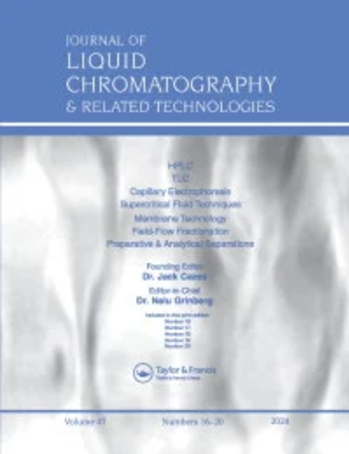Development of a multivariate model with desirability-based optimization for simultaneous determination of five co-administrated drugs for the management of COVID-19 infection in their dosage forms via validated RP-HPLC method
IF 1.2
4区 化学
Q4 BIOCHEMICAL RESEARCH METHODS
Journal of Liquid Chromatography & Related Technologies
Pub Date : 2022-10-02
DOI:10.1080/10826076.2023.2168691
引用次数: 1
Abstract
Abstract More than 2.9 million people have died as a result of the global demographic impact of the coronavirus illness of 2019 (COVID-19). Numerous antiviral and anti-inflammatory medications have FDA approval to treat COVID-19 patients. For the simultaneous determination of COVID-19 utilized medications (Remdesivir, Moxifloxacin, Dexamethasone, Apixaban, and paracetamol) in their dosage forms, a sensitive technique has been developed and validated. The aforementioned medications were separated and quantified with the help of experimental design. The Box-Behnken design was used in the experiment to optimize the chromatographic method’s analytical parameters. It employed RP-HPLC with a UV detector. An INERTSIL ODS-3 C18 column (5 µm, 250 × 4.6 mm) with mobile phase composed of acetonitrile: 30 mmoL potassium dihydrogen phosphate buffer (pH = 7.5) (50:50, v/v), at room temperature was employed to separate the aforementioned drugs. Paracetamol was linear over the concentration range (1–50 µg/mL), Moxifloxacin (5–70 µg/mL), Apixaban (5–70 µg/mL), Dexamethasone (1–100 µg/mL), and Remdesivir (5–100 µg/mL). According to ICH guidelines, the new approach underwent thorough validation. Between the proposed method’s results and those from the reference or reported methods, there was no significant difference. The technique is simple to use in research of the cited medications in their dosage forms for quality control aspects. Graphical Abstract通过经验证的反相高效液相色谱法同时测定五种用于治疗新冠肺炎感染的联合用药的多变量模型的开发
2019年冠状病毒病(COVID-19)对全球人口造成的影响已导致290多万人死亡。许多抗病毒和抗炎药物已获得FDA批准用于治疗COVID-19患者。为了同时检测COVID-19所用药物(瑞德西韦、莫西沙星、地塞米松、阿哌沙班和扑热息痛)的剂型,开发并验证了一种敏感技术。通过实验设计对上述药物进行分离和定量。实验采用Box-Behnken设计优化色谱法的分析参数。采用反相高效液相色谱法,紫外检测器。采用INERTSIL ODS-3 C18色谱柱(5µm, 250 × 4.6 mm),流动相为乙腈:30 mmoL磷酸二氢钾缓冲液(pH = 7.5) (50:50, v/v),室温下分离上述药物。对乙酰氨基酚(1 ~ 50µg/mL)、莫西沙星(5 ~ 70µg/mL)、阿哌沙班(5 ~ 70µg/mL)、地塞米松(1 ~ 100µg/mL)、瑞德西韦(5 ~ 100µg/mL)在浓度范围内呈线性关系。根据ICH指南,新方法经过了彻底的验证。本文方法的结果与文献或报道方法的结果无显著差异。该方法简便,可用于对所引药物的剂型进行质量控制研究。图形抽象
本文章由计算机程序翻译,如有差异,请以英文原文为准。
求助全文
约1分钟内获得全文
求助全文
来源期刊
CiteScore
2.80
自引率
0.00%
发文量
29
审稿时长
4.9 months
期刊介绍:
The Journal of Liquid Chromatography & Related Technologies is an internationally acclaimed forum for fast publication of critical, peer reviewed manuscripts dealing with analytical, preparative and process scale liquid chromatography and all of its related technologies, including TLC, capillary electrophoresis, capillary electrochromatography, supercritical fluid chromatography and extraction, field-flow technologies, affinity, and much more. New separation methodologies are added when they are developed. Papers dealing with research and development results, as well as critical reviews of important technologies, are published in the Journal.

 求助内容:
求助内容: 应助结果提醒方式:
应助结果提醒方式:


